How to Eat in Italy: an Expat’s Guide to Italian Menus & Courses
This Italian foodie guide is exactly what my friends and family ask for when they visit from abroad: A guide to Italian menus, with each meal and course explained, so you can figure out what you’re looking at.
If I’ve learned just one thing in the past year living in Milan, it’s how to eat in Italy. Food here is not just food, it’s a respected art backed by rules and tradition. There is a right way to eat a meal, and your friends (or server) will tell you if you’re doing it the wrong way.
With lots of friends and family about to descend on Milan for our wedding, I’ve been getting a lot of questions lately.
And I’m gleefully realizing how much I’ve learned in the past year about so many aspects of life in Italy – and food is a huge part of Life In Italy. (Of course this also means I must have known nothing a year ago. So it’s okay if you know nothing now.)
UPDATE: Originally published November 24, 2017, I’ve given this Italian menu guide a full edit and update in September, 2022. Most of the info hasn’t changed (we’re talking about food culture generations in the making), but there are a few updates noted.
There are also a lot of steps in the process of a meal – up to eight courses in an Italian dinner, by my count. It’s complicated and even a bit ritualistic – although many of the reasons why are quite logical.
But, logical or not, Italian restaurant meals can be totally overwhelming for the unindoctrinated.
So I’m here to be your guide to the Italian meal – including the differences between all the courses, and how to order in a restaurant. I’ve translated and explained the basic terms you’ll find on menus in Italy.
What’s in this Italian menu guide?
Below is everything I’ve learned about how to navigate every meal, every course, and how to order off the menu in Italian restaurants.
Plus, I’ve added some tips on how to avoid tourist traps in Italy, and look like you know what you’re doing. My hope is that all this helps enjoy the experience of eating in Italy a little bit more.
If you know what you’re looking for, you can jump straight there:
Table of contents
- Colazione – How to Eat Italian Breakfast
- Pranzo – Lunch in Italy
- Aperitivo – Not simply an appetizer
- La Cena – A Guide to Italian Dinner
- L’ Antipasto – The True Italian Appetizer
- L’ Acqua – How to order water in Italy
- Il Vino – Don’t learn how to eat in Italy without learning how to drink
- Il Primo – The first course in Italy
- Il Secondo – The second course in Italy
- Il Contorno – An Italian side dish or vegetable
- La Frutta – Fruit!
- Il Dolce – Dessert time in Italy
- Il Caffé – An espresso after dinner
- Ammazza-caffé – The strong stuff
- Il Conto – Paying your restaurant bill in Italy
- Further Food Reading
Otherwise, let’s start in the morning and eat our way through the day.
Italian Meals:
Colazione – How to Eat Italian Breakfast
Italians go straight to the “bar” for breakfast. But a bar in Italy is not for boozing, it’s for coffee.
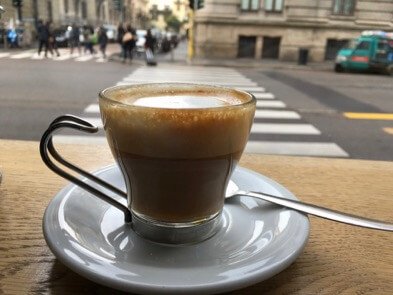
An espresso should cost one euro, a cappuccino up to €1.50. If it’s more than that, you’re in a tourist trap. (And those are generous Milan prices – in Sicily an espresso goes for about 80 cents.)
If you can see a beautiful old church from where you’re sitting – especially if you’re outside – expect to pay €5 for a cappuccino.
2022 UPDATE: As you would expect, these prices have certainly risen – especially in Italy’s most expensive city, Milan. When I was back there in this summer, I found an espresso was often nearly €2.
In many places in Italy, if you’re sitting down at all you’ll pay more for a coffee.
Sometimes you hand your euro to the bartender who made your coffee, sometimes you have to go to the cassa first to pay, then show the barista your ticket. You never know, so look around to see what other people are doing and follow suit.
Italian breakfast isn’t light (there are always pastries, as I explain in this post), but it’s not a big meal and not a big part of Italian food culture.
Pranzo – Lunch in Italy
Lunch. I’m not going to dwell here, because the same rules apply as for dinner, just quicker and usually with more steps skipped. You still have the option for multiple courses.
However, if you’re invited to a pranzo di domenica (Sunday Lunch), all bets are off. Pranzo is a family institution here. The further south you go in Italy, the more traditional it becomes and the more you must eat. Come mentally prepared for Thanksgiving dinner.
Aperitivo – Not simply an appetizer
It’s often translated as “appetizer,” but an aperitivo is really a separate event before dinner – not a starter. Aperitivi (the plural of aperitivo) out can be followed by dinner at home, or at a different restaurant, or they can replace dinner.
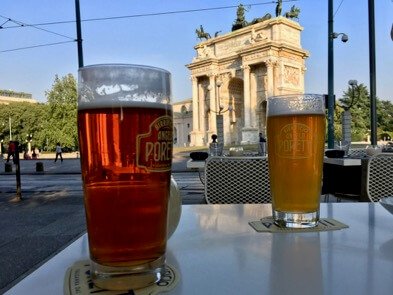
After work, or after a long day of touristing, you can go for an aperitivo and order a drink, which will come with food. Just like at the coffee bar, you never know exactly what the aperitivo situation might be, so it’s okay to ask “how do you do aperitivo here?”
It could be unlimited passes at a buffet with multiple courses including desserts. In Milan, that’ll usually cost €10.
(2022 UPDATE: Alas, prices have risen since I first wrote this guide in 2017, when I lived in Milan. When visiting the city this summer, I noticed the buffet aperitivi at restaurants that I specifically remember used to cost €10 were now at least €15.)
Or it could mean you order your drink and the waiter brings you a plate of finger foods. (Mini pizza, Sicilian arancini, potato chips, olives, salami, and/or cheeses.) This style is my favorite, as opposed to the buffet, mostly just because I’m lazy and don’t want to get up to get my food.
Related: For more about Italian aperitivo culture, check out this post – with recipes and histories for the three main aperitivo cocktails!
So many different ways to do aperitivo
Sometimes aperitivo places are restaurants with full menus, but often they’re not. A lot of places in touristy areas that write “happy hour” on their sandwich boards, but it doesn’t mean the same thing. Don’t expect the two-for-one prices that happy hour usually brings in the US. They just don’t quite know how to translate aperitivo because there isn’t really a translation.
The truly old-school, local places are coffee bars by day and transition into aperitivo bars by early evening.
You’ll see them full of middle-aged men who stop for a glass of wine and to chat or read the paper after work. (Side note: If it’s a pink newspaper, it’s the Gazzetta dello Sport, an all-sports newspaper that I do not understand how anyone could actually enjoy. You’ll see them tucked under the arms of men walking around Milan all the time.)
At some of these local joints you can also buy lottery tickets, bus tickets and most things you would find at a gas station in the US. The aperitivo at these places is probably more toward potato chips, olives, and maybe cold cuts. They’re not replacing dinner for the overworked and underpaid young Milanese – like the buffet places do – they’re just smoothing the transition toward the eating and drinking part of your day.
La Cena – A Guide to Italian Dinner
All of that was just a warm-up for dinner – the main event of the day. And Italian dinners can have a lot of steps to them, especially in restaurants.
You can skip any course, or skip most of them. You can share one course, or share them all – but you never mix up the order.
L’Antipasto – The True Italian Appetizer
Literally “before meal,” this is the real appetizer, and it can be anything. This is the point at which things get serious, as it’s usually part of dinner, while an aperitivo is likely not.
You don’t usually just order an ‘app’ and continue looking at the menu while you munch and chat. No, no.
Italian restaurant eating requires organization from the start:
You go through the entire menu with your dining companions, choose everything you want, decide when you will want it, and pretty much order it all at the same time.
You plan your water (never free in Italy), antipasti, primi, secondi, contorni and vini all from the start – so be ready. (Don’t worry, if you forget something you can always add it later, but at least try to be ready.)
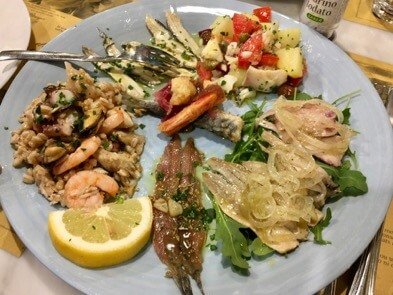
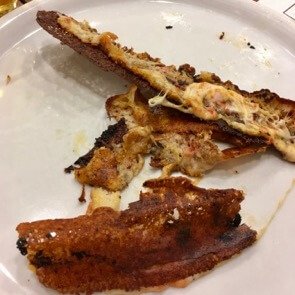
L’Acqua – How to order water in Italy
If you want free water, you’ll have to go to France, where it’s perfectly normal to ask for a pitcher of tap water.
In Italy, you’ll have the choice between a bottle of either still or sparkling mineral water that’ll cost a couple euros.
Water is the very first thing you’ll order in a restaurant in Italy. As you’re taking your seat, a waiter will usually ask simply “sparkling or still?”
There are many names for these waters. Still water is usually called naturale or liscio (smooth). Sparkling is gassata or frizzante and I think there’s a difference between the two, but not a big one. They’re both bubbly water.
Il Vino – Don’t learn how to eat in Italy without learning how to drink
Wine. You already know this word, right?
Red meat and red sauce go with red wine. Seafood and lighter sauces go with white. We have these guidelines in the US, but Italians actually follow them. Still, if you like a different combination, order what you like.
When the server brings the wine, they will ask “Chi assaggia?” (“key asSAWja”) Who’s tasting?
This is your chance to nominate your leader! It’s also a chance to learn something about your friends. Who is deferential? Who wants to be the boss, or pretend to be a wine expert? And who, like me, is just happy to drink wine?
The waiter will then pour a little splash in the taster’s glass and await the verdict before pouring for everyone.
It doesn’t really matter if you’re a wine expert.
The server is asking you to check whether the wine tastes like cork, not to decide whether you like it or would prefer something else. Don’t let the power go to your head.
This doesn’t happen at every restaurant – only the nicer ones do it, but they don’t have to be very fancy. In the US, I’m probably priced out of these places, but Italy is full of reasonably priced restaurants with service and quality I couldn’t afford at home.
When everyone has a glass, say cheers (tchin or salute) and look everyone in the eye individually as you toast with them. But don’t be creepy. Don’t stare people down – just meet their gaze as your glasses touch. I’ve noticed now that non-Italians often don’t make eye contact while clinking glasses, and it’s Italy this is considered very rude.
Il Primo – The first course in Italy
First Course. A first course is usually pasta or rice or pizza. By Italian standards, this means it’s light.
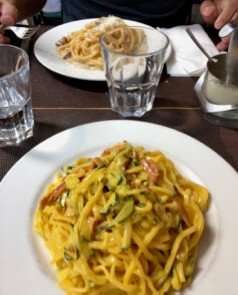
This is one of the least known parts of how to eat in Italy: If you start with meat, you stay with meat for your second course; if you start with fish you stay with fish. Don’t mix, or Italians will think you’re weird and gross.
You will never find chicken in a pasta dish or on any pizza in Italy. Ever.
I used to think these rules were stuffy and pointless, but now they actually make sense to me. You pick a track and let your taste buds stay on that track throughout the meal, instead of jumping around and confusing them.
But again, you can do whatever you want.
Usually the first course is when it’s time to say Buon appetito! (“Bw-own ah-pe-TEE-toe”) You might hear it shortened to buon app! or even tito! especially by young people.
Know what you’re getting yourself into:
If you’re eating out, you already know what you’ve signed up for. But if you’re at someone’s house, it’s not rude to ask, “Will there be a second course? Are we having dessert?”
It took me most of a year to come to terms with the idea that I am allowed to ask and I won’t sound like a nosey, ungrateful glutton, which is exactly how I would feel asking those questions in the US if I didn’t know the hosts well.
The first time I went to a Sunday lunch with the family here in Italy, we snacked on olives and other antipasti until one of the aunts brought a pan of lasagna out of the kitchen and served me a much larger piece than I would have taken on my own.
But it was so good that when she asked if I wanted more, I innocently relented… “just a little bit!” I said, which means nothing here.
I ate my second helping of lasagna and was stuffed. Then I found out lasagna was just the primo. The secondo was pork chops with gravy and rosemary roasted potatoes.
I’m not proud to say that a similar thing happened again at a second family dinner, but after that I did eventually learn.
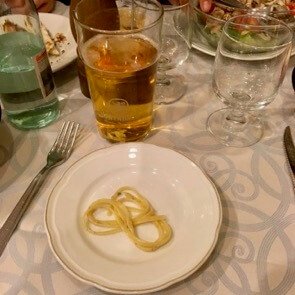
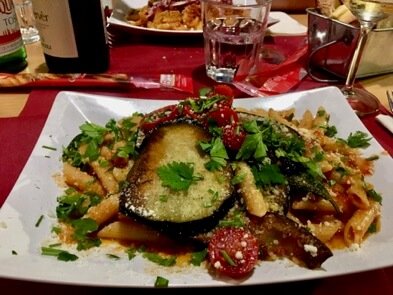
Il Secondo – The second course in Italy
Second Course. Usually a meat or fish dish. Usually larger than a primo.
Not every meal in Italy is meant to be a total binge. So often if you want a secondo, you skip the primo and order a contorno. Or order a primo, with an antipasto first. Or you order antipasti to share (or not) and a primo for yourself, then one secondo to split with your dinner date (romantic or otherwise).
The combinations are endless. Just make sure you stay on your meat or fish track.
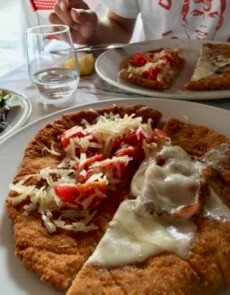
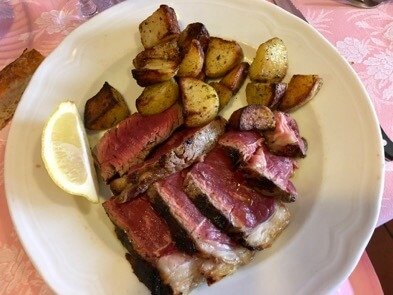
Il Contorno – An Italian side dish or vegetable
Side dish. Vegetables are usually ordered separately. You won’t often see multiple foods on one plate in Italy, so if you’re ordering a pasta or a meat it probably doesn’t “come with” anything.
A contorno can be served whenever you like – with the primo, with the secondo (the most common option), or after both. The waiter will ask you when you want it to arrive. Be ready with your plan.
Whew. Now that you’ve potentially eaten four different plates of food, take a breath because it’s time for a fifth. If you’re in a restaurant, now’s the time to reassess what you’ve done and strategize going forward. If you’re at someone’s house, your host might offer…
La Frutta – Fruit!
Fruit. Dessert’s appetizer! Much more likely at someone’s home than in a restaurant.
Near the end of one of my first Italian dinner parties, I was truly stuffed when the host asked if I wanted some fruit before dessert. I reluctantly said yes for two reasons:
- I didn’t know whether it was rude to say no. (Rookie mistake. You will be given a hard time for refusing pasta, but fruit is truly optional.) And
- I was expecting a couple of blueberries. Maybe a nice little clementine. Instead she gave me a whole apple.
I now know that you’re allowed to say no grazie to fruit.
[If you’re looking for an easy way to eat more fresh fruit and vegetables at home – and reduce food waste – I reviewed a delivery service that’s been surprisingly great!]
Il Dolce – Dessert time in Italy
(“DOLE-chay”) Dessert. Finally. This can overlap with coffee if and only if some people want dessert and some just want an espresso as their dessert. But you don’t normally have coffee first and then dessert. You just don’t.
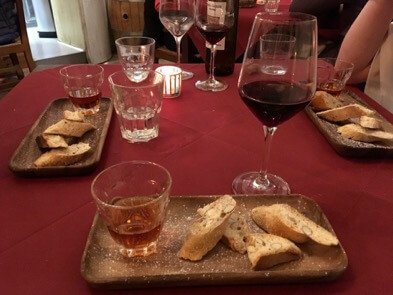
One of my few Italian culinary achievements is that I can make tiramisù and panna cotta – which are factually the best Italian desserts. Even real Italians say my dessert work is good – and they do not give out food compliments lightly.
This brutal honesty has been hard for me to get used to around the table.
No one says something is good if they can say it’s just okay, even at the expense of the cook’s ego. Food is too serious a subject to praise if the praise is not absolutely deserved.
And I guess it makes sense. Since a lot of classic Italian dishes have been around for centuries, people don’t want to encourage straying too from the recipe without a really good reason.
Cooking is truly hyper-local in Italy.
Recipes are often named after a region or even a city or town. By traveling just 30 miles outside of Milan, you’ll find different local specialities that are hard to find in the city (and wouldn’t be nearly as good anywhere else). If culinary traditions weren’t closely guarded, they probably wouldn’t survive.
Il Caffé – An espresso after dinner
Coffee is practically medicinal at this point. Caffeine helps digest everything else.
Side note: contrary to the popular belief of Italians and everyone else, espresso has less caffeine than other preparation methods. The water passes through the coffee grounds so quickly in an espresso machine that it doesn’t absorb as much caffeine as French press or drip-brewed coffee does.
But you can still ask for decaf after dinner (no one will look at you funny).
Beyond that, you have two options: Espresso normale, or espresso macchiato (“MOCK-key-ah-tow”) which means “marked” with a spoonful of milk froth.
Do not order a cappuccino.
Cappuccino is for breakfast – meaning before noon or else you’re a weirdo. Maybe in the afternoon with a sweet treat, but never ever after dinner, when you’re stuffed with prosciutto and cheese and pasta. It’s just not the time for a cup of milk.
Of all the unforgivable food faux-pas (aka, different preferences) that Italians mercilessly mock non-Italians for, this is the biggest one. (Even though Starbucks recently opened its first Italian shop here in Milan, Italians still don’t drink large, milky coffees after dinner.) You have been warned.
Even the waiter will inform you “that’s not how we do it here,” and suggest an espresso or espresso macchiato instead. Any Italians around you will roll their eyes.
There are two perfectly legitimate responses to this:
- Who Cares? I agree with that. I’m a big fan of enjoying what you like, not just doing what’s expected, so if you want a cappuccino, order a cappuccino.
- Okay, I’ll try it… Because I’m also a fan of trying life the ways the locals live it. After all, isn’t that the point of travel? I ate a fried tarantula at a bus stop snack-stand in Cambodia. In Guatemala, I lived on scrambled eggs, fried plantains, beans and rice for a month. If you’re in Italy, it probably won’t hurt you to try your espresso the Italian way once or twice.
Coffee vs Caffé vs Espresso:
When Italians say coffee or caffé, it means espresso. There is no other. Whether you ask for un espresso or un caffé or either of those with the word normale after, you will get the same roughly one-ounce shot, straight up.
If you ask for un latte, that’s just milk. Latte macchiato is what we know as a latte in the US.
It does exist here – obviously the name is Italian – but I’ve only very rarely heard a local actually order one.
In Napoli, I’ve heard that it used to be hard to convince baristas not to pre-sugar your coffee, but from what I’ve experienced in that beautiful city, that’s changing a bit. But still serve their espresso very strong, very dark, and very hot in Naples. (Even the cups are often pre-heated, for reasons I do not understand, as it often makes them impossible to even touch.)
Ammazza-caffé – The strong stuff
(“am-MATZah cahf-FAY”) “Coffee killer” means after-dinner booze! Also known (more formally and more commonly) as a digestive – un digestivo. But coffee killer is by far my favorite term.
The classics are limoncello, grappa and so many types of amaro, but there are others.
Many are infused with herbs and some amount of sugar. People will tell you the herbs and booze together are an ancient medicinal concoction that aids digestion, which might be true. But a digestive will definitely have the pleasant effect of helping you forget how much you’ve just eaten.
Two of my favorites are Amaro del Capo (a not-too sweet, more herby amaro) and mirto (a specialty of the island of Sardinia – fruitier and a bit sweeter, less herby).
Sometimes the digestivo is on the house in Italy. A bottle (or several) might appear on the table with glasses without you even asking for it – self-serve.
Sometimes the waiter just brings glasses of the house digestivo, or asks what everyone would like (often after the bill is delivered).
Hint: “Can we offer you a digestive?” = Probably free.
“Would you like a digestive?” especially if you’re in a touristy area = Probably not free.
Just see what happens.

Il Conto – Paying your restaurant bill in Italy
The check. (“il CONE-toe”) It had to come to this. Take solace in the fact you’ll probably pay a fraction of what you’d pay in an Italian restaurant anywhere else in the world for the feast you just enjoyed.
You can ask for the check at the table, but it’s usually settled at the cassa (register), especially if you pay with a card.
Fun fact: The Italian language has lots of different ways of splitting the check, named after Italian cities and regional stereotypes.
- Paying alla Romana is the most common one – just splitting the total four ways if there are four people eating, for example.
- Alla Milanese means sitting down with a pen and calculator and divvying up each person’s due, down to the last bottle of water, dolce and cover charge. I suppose this is because Milan is the working city – people move here from all over the country for jobs, and the prices are higher than anywhere else.
There are several other local legends about how people settle the bill, each backed by regional stereotypes that are a huge part of Italian culture.
Il Coperto – The sneaky charge on your Italian restaurant bill
Cover charge.
This is a fee, of usually €1 to €3 per person, that almost all restaurants in Italy change to cover the cost of things like bread, salt and napkins. But it’s NOT for a tip, because Italians don’t tip. Il coperto is the only extra charge that will be added to what you order – tax is included in the price you see on the menu
A lot of foreigners find cover charges really annoying because they’re just not used to the system. (The same way Europeans find the need to tip 15 – 20% in US restaurants, and the fact that tax is not included in prices, equally annoying.)
So if you see restaurants in Italy with signs outside advertising “no cover charge!” you know they’re for tourists.
Avoid them like the plague. Start walking further away from whatever major monument you’re near and any restaurant you find will be better than a place that caters specifically to tourists who don’t know how to eat in Italy.
So, should you tip at restaurants in Italy?
Of course there are exceptions to the rule that people don’t tip in Italy (or really in most of Europe). If the service is really outstanding, or they just feel like it, people might leave a euro or five, but not 15 to 20% as is the norm in the US.
Does this mean waiters earn a good wage without tips? As a rule, not necessarily. I keep asking people and getting mixed responses.
So leave something if you feel like it, but know that tipping is uncommon and completely optional in Italy.
And if you do leave a tip, 20% would be shocking and confusing. But a couple of coins is appreciated. Or even 5 or 10 euros after a nice dinner would make your server very happy – but again, it’s not considered rude to not tip in Italy.
So there you have it – hopefully you now know everything you need to know about dining and ordering from menus in Italy!
Never mix up the courses. Always know what you’re getting yourself into. And enjoy.
If you have questions about Italian menus or food culture/etiquette, leave them in the comments below, and I’ll do my best to help!
And if you enjoyed that, you’ll want to read this article about the differences between how Americans and Italians eat. (The answer to the question I get all the time: Why are Italians so thin with all the pizza and pasta they eat??)
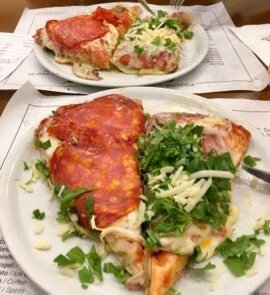
Further Food Reading
If you’re as fascinated as I am by food culture, history, production and everything else about food, here are a couple of books I recommend:
- Heat, by Bill Buford. The story of an American magazine editor who gets a job in Mario Batali’s restaurant, and eventually goes to Italy to try to learn everything he can about Italian food. It reads like a hilarious novel, and is full of Italian food culture and history. You can order Heat on Bookshop here (if they get it back in stock).
- Anything by Michael Pollan, but especially Cooked, which is kind of a global history of the development of food culture. Netflix has a series based on this book, but the stories and characters are so different that it doesn’t even seem related. The book is definitely worth your time. Here’s a preview, and here’s Cooked on Bookshop.
- A History of the World in Six Glasses, by Tom Standage. Fascinating history of how beer, wine, rum, coffee, tea, and Coca-Cola influenced world history. Excerpt here. Order it on Bookshop here.
For more great books about food culture, check out my foodie list on Bookshop.org (one of my favorite sustainable small businesses).


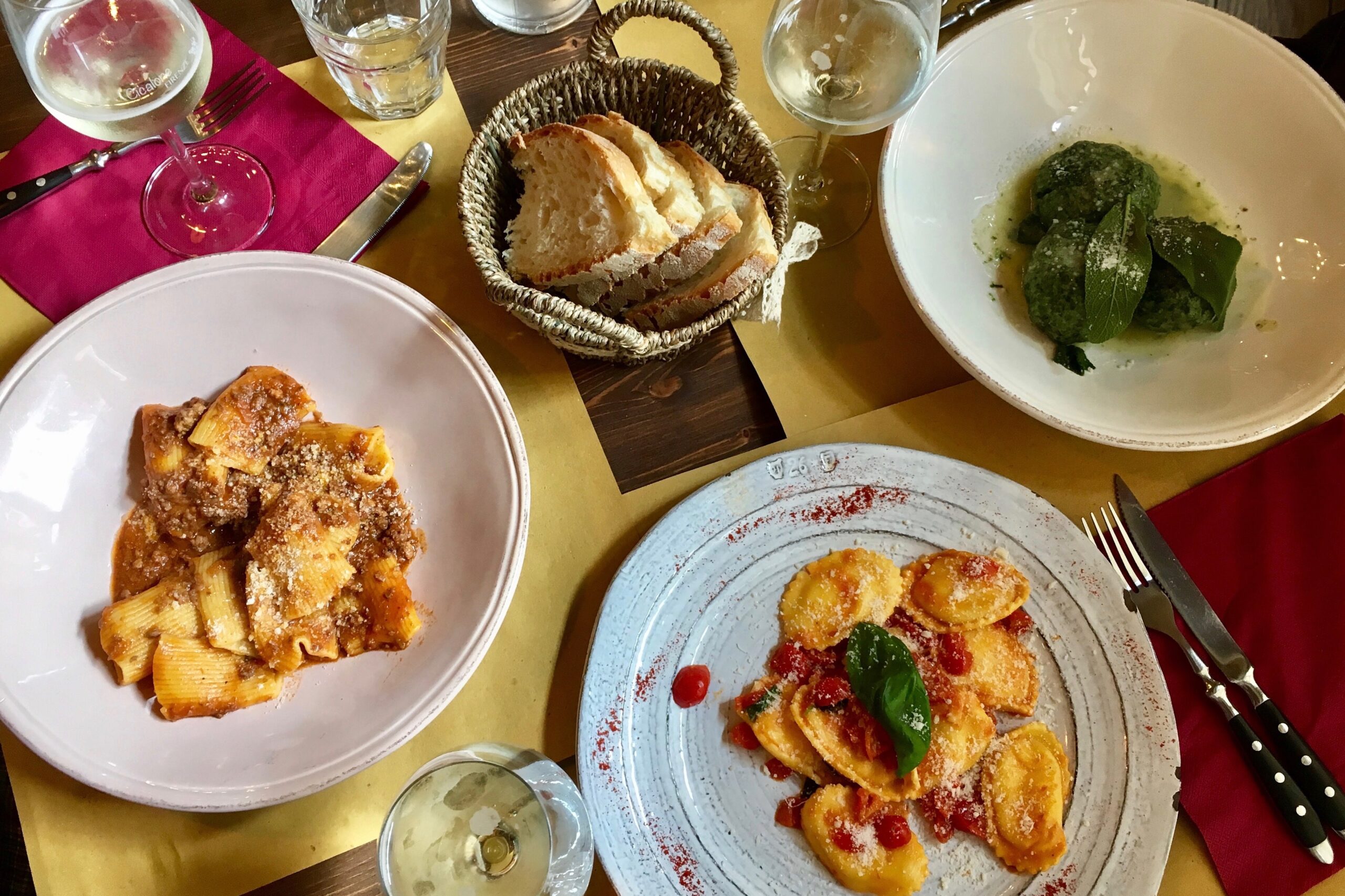


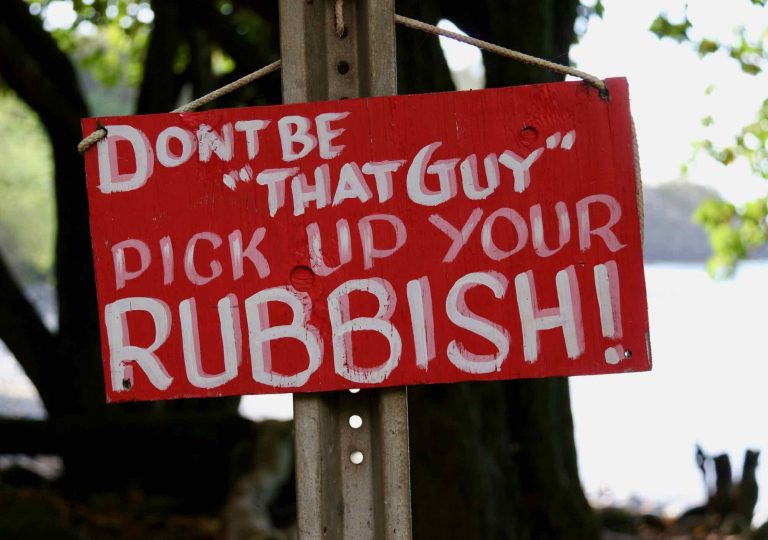


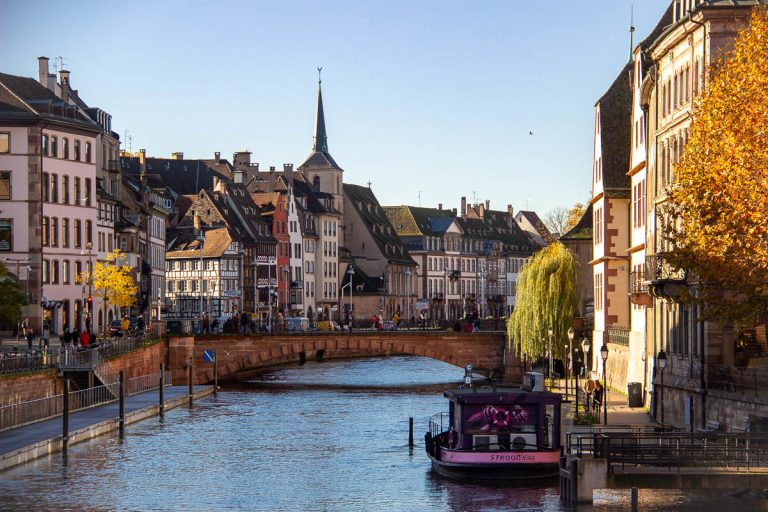
Ketti…mahalo nui loa from Oakland, CA. regarding your most informative article on ”How to Eat in Italy.” This will be especially relevant to myself and my wife as we travel to Italy later in May. We will visit many places for the first time—including Rome, Florence & Tuscany region, and further north to Milano…possibly Turin beforehand if time allows. I’ve also been honored with the opportunity to be the speaker at CreativeMornings Milano on May 24th on the theme of “Preserve.” Perhaps we will cross paths that morning.
All the best in your new marriage and continued grad studies…keep
up the fine writing!
Sincerely,
Keith W. Criss
Tradigtalworks
510.534.0340 : Studio
510.500.6108 : Mobile
[email protected]
https://kcriss.myportfolio.com/
Hi Keith,
Thank you for reaching out! I’m always happy to hear when my writing is useful to someone. If I’m in Milan at that time, I’ll make sure to stop by Creative Mornings for your talk. Buon viaggio!
Best,
Ketti
Hello Katti,
Keith again. I hope all is well. Whew…getting close to our departure time to Italy. I thought I’d ask about any recommendations for fine local cooking in Milano you may share with a few outta towners? Maybe also Florence and Rome. The images in your article are so enticing! Only if you have a spare moment. Mahalo…grazie!
All the best,
KC
Hi Ketti!I enjoyed reading this blog! I do remember noticing the espresso bars turning into aperitivo bars towards the end of the day 🙂 But now I am laughing thinking we would order capuccino all day long (because they’re just so good!) so now I know they’re shaking their heads “tourists” when we would order it during our afternoon breaks LOL. Thanks for all the tips – Italy is for sure one of the places I will keep going back to, so these tips will come handy !
Maria
Happy to help! 🙂 But a cappuccino for an afternoon break is really fine, even by Italian standards. It’s not as common as in N. America and the UK, but it’s normal to order a cappuccino with a pastry in the afternoon.
It’s only considered weird right after lunch or dinner, when you’ve just finished a meal. Italians would only order an espresso or espresso macchiato when they’re full of food, but not a heavy cappuccino. (Which is one of those things that seems incredibly pretentious at first, but then it actually makes sense… like, digestively!)
Maybe I should clarify this in the post. Thanks for your comment!
-Ketti
Good article! I come across your blog as I want to know how to order in a real Italian restaurant, with the antipasti, primi and secondi thingy. And I have been living in Europe for 17 years, haha! I just thought that it’s impossible for a normal person to eat all the 5 courses.
Also thanks for the book suggestions!
Thank you, Agnes! I’m so glad you enjoyed it. 🙂 I also have a few more articles about Italian food you might like.
And don’t forget to keep in touch if you want! Always happy to hear any questions readers have about Italy.
Cheers!
Ketti